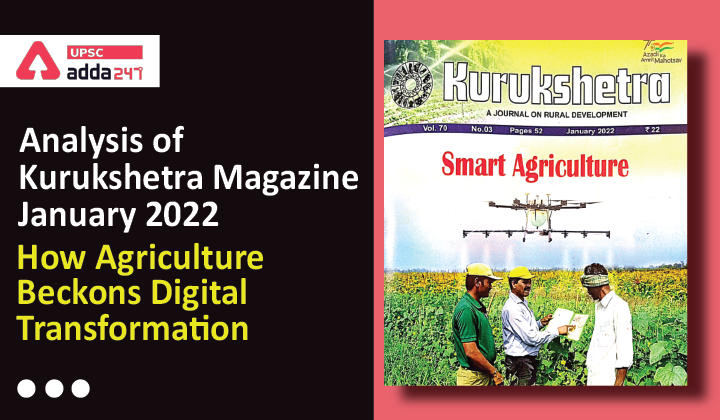Table of Contents
Relevance
”GS 2 & GS 3: Government Policies & Interventions, Agricultural Marketing, Agricultural Pricing”
Introduction
- According to the World Bank, the world’s roughly 500 million smallholder farmers who contribute 80 percent of our food are amongst the poorest and most malnourished groups.
- In fact, climate change could force over 100 million people into extreme poverty by 2030, mostly through impacts on agriculture and food security.
- Also, today’s food system is the main driver of deforestation and biodiversity loss and generates a quarter of the greenhouse gas pollution globally.
- In that situation, the ongoing digital revolution could be transformative for food and agriculture, and create more efficient, equitable, and environmentally sustainable ways to feed the world.
Importance of Digitalization of Agriculture Sector
- Realizing the significance of new digital & emerging technologies, the Committee on Doubling Farmers’ Income (DFI) has recommended further expanding and augmenting of the digital agriculture initiatives of Government of India.
- As it helps in focusing on modern management of agriculture viz. Remote Sensing; Geographical Information System; Data Analytics and Cloud Computing; Artificial Intelligence & Machine Learning; Internet of Things; Robotics, Drones & Sensors and Block-chain.
- Expanding digital opportunity for all, including farmers and agribusiness, will improve the food system outcomes in both rural and urban areas.
- Use of digital technology can help reduce costs, help farmers make more precise decisions, and improve access to information, knowledge and markets.
Initiatives to enable digitalisation of the agricultural sector in the country
- India Digital Ecosystem of Agriculture (IDEA) framework – This would lay down the architecture for the federated farmers’ database is being built by taking the publicly available data as existing in various schemes and linking them with the digitized land records. The IDEA would serve as a foundation to build innovative agri-focused solutions leveraging emerging technologies to contribute effectively in creating a better Ecosystem for Agriculture in India.
- Under plan scheme viz. National e-Governance Plan in Agriculture (NeGP-A) wherein, funds are released to the State(s)/UT(s) for projects involving the use of modern technologies viz. Artificial Intelligence (AI), Machine Learning (ML), Robotics, Drones, Data Analytics, BlockChain etc.
- National Agriculture Market (e-NAM)– The government of India has launched the National Agriculture Market (e-NAM) scheme with the objective of creating an online transparent competitive bidding system to facilitate farmers with remunerative prices for their produce.
- Digital Portals- To make provisions of subsidy for farm machinery more transparent Government has developed Direct Benefit Transfer (DBT) portal, Centralized Farm Machinery Performance Testing Portal and FARMS Mobile App.
- Krishi Yantra App – Central Institute of Agricultural Engineering, Bhopal (ICAR-CIAE) under the Indian Council of Agricultural Research(ICAR) has developed Krishi Yantra App to augment the research, operations and technology dissemination process in the field of agricultural engineering.
- Other Mobile Apps by ICAR-CIAE –
-
- ‘Farm mech’ App: The App is related to decision support for the selection of suitable farm machineries for five major crops of Tamil Nadu. It also has dynamic Networking of 2250 Custom hiring service operators on the Android platform.
- ‘Farm Safety’: Provides information about Safety Guidelines and Safety Gadgets to avoid accidents while using different type of agricultural machinery.
- Water Balance Simulation Model for Roof Water Harvesting (Mobile App): It is helpful to decision-makers to make recommendations for design requirements where roof water harvesting system adoption may lead to water-saving and water security.
What is National eGovernance Plan in Agriculture (NeGPA)?
- NeGPA aims to achieve rapid development in India through the use of Information & Communication Technology (ICT) for timely access to agriculture-related information for the farmers.
- During Phase I of the scheme, the hardware were centrally procured and distributed to all the 7 pilot states.
- The National eGovernance Plan in Agriculture (NeGPA) has been modified to include new & emerging technologies in the field of Digital Agriculture. During the last financial year (2020-21), pilot projects have been sanctioned in 10 States as per this modified NeGPA.
What is Unified Farmer Service Platform (UFSP)?
UFSP is a combination of Core Infrastructure, Data, Applications and Tools that enable seamless interoperability of various public and private IT systems in the agriculture ecosystem across the country. UFSP is envisaged to play the following role:
- Act as a central agency in the agri ecosystem (like UPI in the e Payments)
- Enables Registration of the Service Providers, public and private
- Enables Registration of the Farmer Services G2F, G2B, B2F and B2B
- Enforces various rules and validations required during the service delivery process
- Acts as a Repository of all the applicable standards, API’s and formats
- It shall also act as a medium of data exchange amongst various schemes and services to enable comprehensive delivery of services to the farmer.
What is the nationwide Farmers’ Database?
For better planning, monitoring, policy-making, strategy formulation and smooth implementation of schemes for the farmers a nationwide Farmers Database linked with land records is being created with the following objective:
- Develop a nationwide database of farmers.
- Keep a record of unique farmers.
- Unique farmer ID (FID) to uniquely identify a farmer.
- To know benefits availed by a farmer under various schemes.
Conclusion
While digital technologies have significant potential they also pose several risks, including an over-concentration of service providers; lack of data privacy; exclusion and potential job losses for some activities; and cyber security breaches. What’s needed are to: keep service provider entry barriers low; ensure good data governance; targeted support to smallholder farmers, youth, women, and other vulnerable groups; and support skill development.



 TSPSC Group 1 Question Paper 2024, Downl...
TSPSC Group 1 Question Paper 2024, Downl...
 TSPSC Group 1 Answer key 2024 Out, Downl...
TSPSC Group 1 Answer key 2024 Out, Downl...
 UPSC Prelims 2024 Question Paper, Downlo...
UPSC Prelims 2024 Question Paper, Downlo...
